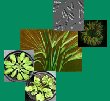| Kerl, C; Rafferty, C; Clemens, S; Planer-Friedrich, B: Monothioarsenate uptake, transformation, and translocation in rice plants., Environmental Science & Technology (2018), doi:10.1021/acs.est.8b02202 | |
| Abstract: Thioarsenates form under sulfur-reducing conditions in paddy soil pore waters. Sulfur fertilization, recently promoted for decreasing total arsenic (As) grain concentrations, could enhance their formation. Yet, to date, thioarsenate toxicity, uptake, transformation, and translocation in rice are unknown. Our growth inhibition experiments showed that the toxicity of monothioarsenate (MTA) was similar to that of arsenate but lower than that of arsenite. Higher toxicity of MTA with lower phosphate availability might imply uptake through phosphate transporters similar to arsenate. To demonstrate direct uptake of MTA by rice plants, a species-preserving extraction method for plant samples was developed. When plants were exposed to 10 μM MTA for 72 h, up to 19% and 4% of total As accumulated in roots and shoots, respectively, was MTA. Monothioarsenate was detected in xylem sap and root exudates, and its reduction to arsenite in rice roots and shoots was shown. Total As uptake was lower upon exposure to MTA compared to arsenate, but root to shoot translocation was higher, resulting in comparable As shoot concentrations. Thus, before promoting sulfur fertilization, uptake and detoxifying mechanisms of thioarsenates as well as potential contribution to grain As accumulation need to be better understood. |

Letzte Änderung 28.01.2020

